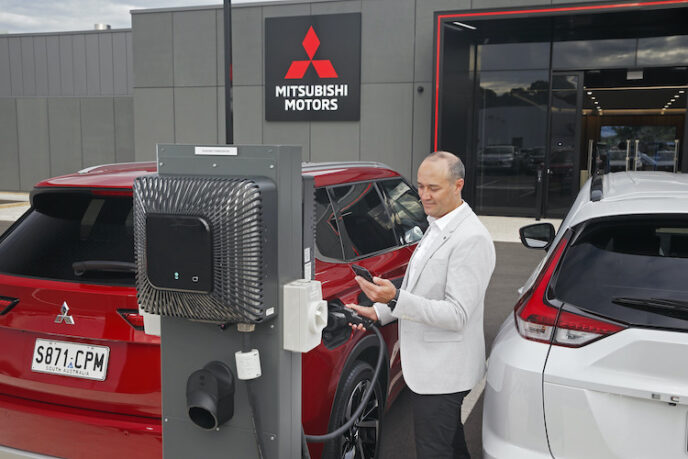
Mitsubishi Motors Australia Limited (MMAL) has installed bi-directional EV charging infrastructure facilitating vehicle to grid capability at its Adelaide head office.
Working with EV charging specialist JET Charge, MMAL now has two bi-directional Wallbox Quasar chargers operating at its head office near the Adelaide airport.
These chargers allow CHAdeMO-enabled EVs to both charge their drive batteries and supply their stored energy back to the grid.
MMAL is the first automotive OEM to install this capability at its Australian headquarters, the update being the next step in activating Mitsubishi’s Dendo Drive House energy management system.
“We are immensely proud to be the first automotive brand in Australia with bi-directional charging capability,” MMAL chief executive Shaun Westcott says.
“It’s the next step in realising our vision to deploy Mitsubishi Plug-in Hybrid EV technology and become a more environmentally sustainable operation. Recent power outages are a timely reminder of this technology’s value.
“We thank JET Charge for their technical collaboration and commitment in delivering this project and look forward to seeing this technology roll out across South Australia and the country in future.
“It is this work that allows businesses such as MMAL to explore new mobility pathways that result in improved integration between the mobility and energy sectors.
“The eMobility space is continually evolving, and likewise we are evolving how Mitsubishi Plug-In Hybrid EV users can unlock the benefits of battery energy storage on wheels, and how this can support the grid of the future,” he says.
With its bi-directional capability, Mitsubishi can use its PHEV vehicle fleet to supply energy to its Head Office – or the grid. Additionally, the new Outlander Plug-in Hybrid EV can act as a mobile generator and is able to supply energy to a typical Australian home for up to seven days.
MMAL sees its head office as a pilot study for deployment of bi-directional charging in homes and businesses around Australia in future.
What is bi-directional charging?
Bi-directional charging is the next evolution in the interaction between electric vehicles and energy infrastructure, allowing two-way transfer into and out of the EV or PHEV vehicle’s on-board battery storage system according to MMAL.
This enables the user to deploy the stored energy in several ways; for mobility; to supply their home (V2H) or business (V2B); or to supply energy back to the grid (V2G).
A bi-directional charger works similarly to a conventional DC charger, converting AC electricity from the grid to the DC electricity required by EV batteries, but it is also capable of converting this electricity back from DC to AC. As a result, the stored energy can be drawn from the vehicle’s battery and supplied externally.
The new Mitsubishi Outlander Plug-in Hybrid EV and Eclipse Cross Plug-in Hybrid EV models are bi-directional capable as standard, via their CHAdeMO DC charging ports.
What is Vehicle to Grid?
Vehicle to Grid, or V2G, is when a bi-directional charger is connected to an EV Battery allowing electricity from the battery to be supplied to the grid, or to supply a home or building connected to the grid says MMAL.
V2G has the potential to assist with grid stability during supply and demand fluctuations and with congestion management (store during low demand and supply during high demand). It can also be used for price arbitrage (buy low/sell high).
All of these use cases have the potential to unlock new value streams for the user, while offering wider benefits to all grid users, such as increased grid reliability, increased renewable energy mix, and cheaper energy prices.
Vehicle to Grid technology has the potential to transform the way we utilise vehicles, transport and energy in our day-to-day lives according to MMAL.








